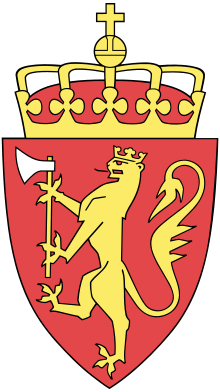Enebakk
Enebakk is a municipality in Akershus in Viken county, Norway. It is part of the Follo traditional region. The administrative centre of the municipality is the village of Kirkebygda. The parish of Enebak was established as a municipality on 1 January 1838 (see formannskapsdistrikt). The part of Enebakk lying east of lake Øyeren was transferred to Fet municipality in 1962.
Enebakk kommune | |
|---|---|
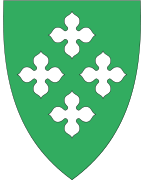 Coat of arms 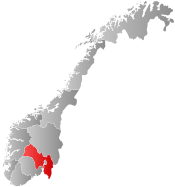 Viken within Norway | |
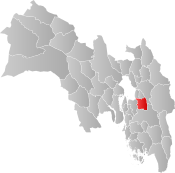 Enebakk within Viken | |
| Coordinates: 59°46′27″N 11°6′7″E | |
| Country | Norway |
| County | Viken |
| District | Follo |
| Administrative centre | Kirkebygda |
| Government | |
| • Mayor (2015) | Øystein Slette (Labour) |
| Area | |
| • Total | 233 km2 (90 sq mi) |
| • Land | 195 km2 (75 sq mi) |
| Area rank | 312 in Norway |
| Population (2004) | |
| • Total | 9,233 |
| • Rank | 111 in Norway |
| • Density | 47/km2 (120/sq mi) |
| • Change (10 years) | 14.5% |
| Demonym(s) | Enebakking[1] |
| Time zone | UTC+01:00 (CET) |
| • Summer (DST) | UTC+02:00 (CEST) |
| ISO 3166 code | NO-3028 |
| Official language form | Bokmål[2] |
| Website | www |
General information
Name
The municipality (originally the parish) is named after the old Enebakk farm (Old Norse: Ignarbakki), since the first church was built here. The first element is the genitive case of a river name Ign (the meaning is unknown) and the last element is bakki which means "river bank". In Norse times the parish was alternatively called Ignardalr meaning "the valley of (the river) Ign". Prior to 1921, the name was written "Enebak".[3]
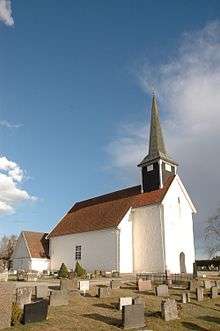
Enebakk Church
Enebakk Church (Enebakk kirke) dated from 11th-12th century. It is constructed in a rectangular shape. The edifice is of stone and has 280 seats. The present church has since been expanded and undergone major restorations, the latest in 2010. Enebakk church is a medieval era church, with a rectangular nave and finished choir. Portals and corners are quarried sandstone, while the church was constructed by the macadam. The nave and chancel were built in the 1100s, while the west tower was built during the 1200s. The tower was originally higher than now, but was rebuilt around 1520. The ridge turret of the tower roof was built in 1622, and is thus the oldest preserved wooden tower in the country.[4]
The frescoes in the nave were uncovered in the 1960s. They were originally painted in the late 1500s and covered all the walls, but were later painted over after the Reformation. The decoration is done in Renaissance style. In 1608 the church received a new altar with catechism boards, which are an altarpiece without pictures, just text. The altarpiece was later elevated to a picture field showing the Crucifixion. This was done in the 1660s. The baptismal font from the 1100s is of soapstone with Romanesque decoration. The church has two wooden sculptures: a crucifix hanging above the chancel arch and a Madonna both in Gothic style.[5]
Coat-of-arms
The coat-of-arms is from modern times. They were granted on 12 December 1986. The arms are based on a drawing in the local church that dates back to the early 17th century. They show four silver crosses on a green background. It is inspired by old mural paintings in the Enebakk church from the Middle Ages. It shows four fourblades. The number four symbolizes the four parts of the municipality (see below).[6]
| Ancestry | Number |
|---|---|
| 397 | |
| 114 | |
| 101 | |
| 98 | |
| 58 | |
| 54 | |
| 51 | |
| 48 |
Media
The newspaper Enebakk Avis is published in Enebakk.[8]
Geography
Enebakk is divided into four areas, named Flateby (Postcode 1911), Kirkebygda (Postcode 1912), and Ytre Enebakk (Postcode 1914), being closest to Oslo.
The highest point in Enebakk is Vardåsen, situated between the lakes Børtervann and Øyeren, at 374 metres (1,227 ft) above sea level.
Enebakk is a mere 30 kilometres (18.6 mi) from the city limits of Oslo, with easy bus-access to the country's capital. As of 2004, there are no train stations in the municipality.
Sister cities
The following cities are twinned with Enebakk:[9]
References
- "Navn på steder og personer: Innbyggjarnamn" (in Norwegian). Språkrådet.
- "Forskrift om målvedtak i kommunar og fylkeskommunar" (in Norwegian). Lovdata.no.
- Unger, Carl Rikard (1896). Sproglig-historiske studier (in Norwegian). Kristiania, Norge: H. Aschehoug & Co. p. 55. Retrieved 2008-12-18.
- "Enebakk kirkested". Riksantikvaren. Retrieved October 1, 2016.
- "Enebakk kirke". Den norske kirke. Retrieved October 1, 2016.
- Norske Kommunevåpen (1990). "Nye kommunevåbener i Norden". Archived from the original on 2012-10-05. Retrieved 2008-12-18.
- "Immigrants and Norwegian-born to immigrant parents, by immigration category, country background and percentages of the population". ssb.no. Archived from the original on 25 July 2017. Retrieved 29 June 2015.
- Store norske leksikon: Enebakk Avis.
- Jakobsen, Kate S. (2008-10-09). "Kommunens prioriteringer" (in Norwegian). Enebakk Avis. Retrieved 2008-12-16.
External links


- Municipal fact sheet from Statistics Norway

- Official website (in Norwegian)
